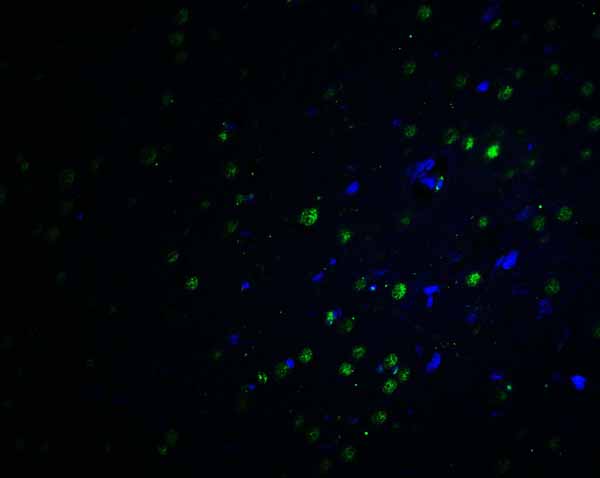MECR Antibody
- SPECIFICATION
- CITATIONS
- PROTOCOLS
- BACKGROUND

Application
| WB, E |
|---|---|
| Primary Accession | Q9BV79 |
| Other Accession | NP_057095, 51102 |
| Reactivity | Human, Mouse, Rat |
| Host | Rabbit |
| Clonality | Polyclonal |
| Isotype | IgG |
| Calculated MW | Predicted: 41 kDa |
| Application Notes | MECR antibody can be used for detection of MECR by Western blot at 1 - 2 μg/mL. |
| Gene ID | 51102 |
|---|---|
| Target/Specificity | Rabbit polyclonal MECR antibody was raised against a 15 amino acid peptide near the carboxy terminus of human MECR. The immunogen is located within amino acids 300 - 350 of MECR. |
| Reconstitution & Storage | MECR antibody can be stored at 4℃ for three months and -20℃, stable for up to one year. |
| Precautions | MECR Antibody is for research use only and not for use in diagnostic or therapeutic procedures. |
| Name | MECR |
|---|---|
| Synonyms | NBRF1 |
| Function | Catalyzes the NADPH-dependent reduction of trans-2-enoyl thioesters in mitochondrial fatty acid synthesis (fatty acid synthesis type II). Fatty acid chain elongation in mitochondria uses acyl carrier protein (ACP) as an acyl group carrier, but the enzyme accepts both ACP and CoA thioesters as substrates in vitro. Displays a preference for medium-chain over short- and long-chain substrates (PubMed:12654921, PubMed:18479707, PubMed:27817865). May provide the octanoyl chain used for lipoic acid biosynthesis, regulating protein lipoylation and mitochondrial respiratory activity particularly in Purkinje cells (By similarity). Involved in iron homeostasis; affecting Fe-S cluster assembly and ceramide metabolism (PubMed:37653044). Required for proper morphology and bioenergetic functions of mitochondria (PubMed:37653044). Required for maintenance of neurons (By similarity). |
| Cellular Location | [Isoform 1]: Mitochondrion |
| Tissue Location | Highly expressed in skeletal and heart muscle. Expressed at lower level in placenta, liver, kidney and pancreas Weakly or not expressed in lung. |

Thousands of laboratories across the world have published research that depended on the performance of antibodies from Abcepta to advance their research. Check out links to articles that cite our products in major peer-reviewed journals, organized by research category.
info@abcepta.com, and receive a free "I Love Antibodies" mug.
Provided below are standard protocols that you may find useful for product applications.
Background
MECR Antibody: The mitochondrial trans-2-enoyl-CoA reductase (MECR), was initially identified as nuclear receptor-binding factor 1 (NRBF1), which can interact with a multitude of nuclear hormone receptors in the presence of the respective ligands. MECR has been shown to be part of the mitochondrial fatty acid synthesis (FAS II) system and to catalyze the NAPDH-dependent reduction of 2-enoyl thioesters, generating saturated acyl-groups. Overexpression of this gene in transgenic mice can lead to cardiac abnormalities, suggesting that inappropriate expression of genes of FAS II can result in the development of hereditary cardiomyopathy.
References
Masuda N, Yasumo H, Furusawa T, et al. Nuclear receptor binding factor-1 (NRBF-1), a protein interacting with a wide spectrum of nuclear hormone receptors. Gene 1998; 221:225-33.
Chen Z, Leskinen H, Liimatta E, et al. Myocardial overexpression of Mecr, a gene of mitochondrial FAS II leads to cardiac dysfunction in mouse. PLoS One 2009; 4:e5589.
If you have used an Abcepta product and would like to share how it has performed, please click on the "Submit Review" button and provide the requested information. Our staff will examine and post your review and contact you if needed.
If you have any additional inquiries please email technical services at tech@abcepta.com.













 Foundational characteristics of cancer include proliferation, angiogenesis, migration, evasion of apoptosis, and cellular immortality. Find key markers for these cellular processes and antibodies to detect them.
Foundational characteristics of cancer include proliferation, angiogenesis, migration, evasion of apoptosis, and cellular immortality. Find key markers for these cellular processes and antibodies to detect them. The SUMOplot™ Analysis Program predicts and scores sumoylation sites in your protein. SUMOylation is a post-translational modification involved in various cellular processes, such as nuclear-cytosolic transport, transcriptional regulation, apoptosis, protein stability, response to stress, and progression through the cell cycle.
The SUMOplot™ Analysis Program predicts and scores sumoylation sites in your protein. SUMOylation is a post-translational modification involved in various cellular processes, such as nuclear-cytosolic transport, transcriptional regulation, apoptosis, protein stability, response to stress, and progression through the cell cycle. The Autophagy Receptor Motif Plotter predicts and scores autophagy receptor binding sites in your protein. Identifying proteins connected to this pathway is critical to understanding the role of autophagy in physiological as well as pathological processes such as development, differentiation, neurodegenerative diseases, stress, infection, and cancer.
The Autophagy Receptor Motif Plotter predicts and scores autophagy receptor binding sites in your protein. Identifying proteins connected to this pathway is critical to understanding the role of autophagy in physiological as well as pathological processes such as development, differentiation, neurodegenerative diseases, stress, infection, and cancer.


